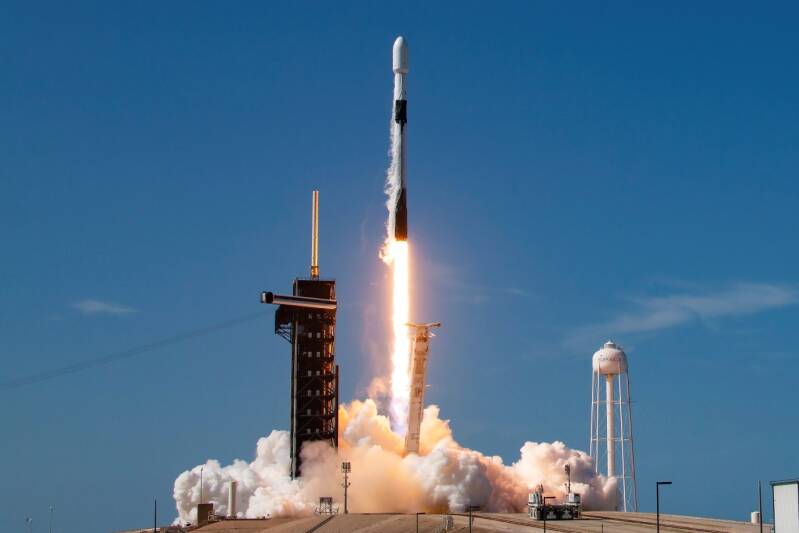A state-of-the-art European satellite designed to enhance weather forecasting and air quality monitoring across Europe and North Africa was successfully launched into space Tuesday evening aboard a SpaceX Falcon 9 rocket.

SpaceX Falcon 9 rocket lifts off from Launch Complex 39A with the Meteosat Third Generation Sounder (MTG-S1) satellite from the European Oganisation for the Exploration of Meteorological Satellites (EUMETSAT). Credit: SpaceX
Lifting off at 5:04 p.m. EDT (2104 UTC) from NASA’s Kennedy Space Center’s Launch Complex 39A, the rocket carried the Meteosat Third Generation Sounder (MTG-S1) into a geosynchronous transfer orbit. Once fully operational, the satellite will take its position in geostationary orbit approximately 36,000 kilometers (22,369 miles) above the equator.
The mission is a joint effort between the European Space Agency (ESA) and EUMETSAT, and it represents a major leap forward in Europe’s meteorological and environmental satellite capabilities. MTG-S1 is Europe’s first hyperspectral sounder to be deployed in geostationary orbit, allowing it to capture vertical profiles of temperature and humidity in the atmosphere every 15 minutes—a critical asset for early detection of severe weather events.
“This satellite will be transformative in how we monitor atmospheric conditions in real time,” said James Champion, ESA’s MTG project manager. “We’re thrilled to start operations soon.”
MTG-S1 was launched atop a Falcon 9 first-stage booster numbered B1085, marking its ninth flight. The booster, previously used in missions such as NASA's Crew-9 and Firefly Aerospace's Blue Ghost Mission 1, successfully landed on the droneship Just Read the Instructions roughly 8.5 minutes after liftoff. This recovery marks the 127th landing for the ship and 471st Falcon booster recovery overall.
After separating from the second stage about 35 minutes after launch, the satellite will undergo a 17-day orbital transfer to reach its final destination. Once in position, a 9–12 month commissioning phase will begin, during which onboard instruments will be carefully calibrated.
The satellite’s hyperspectral sounder payload weighs approximately 400 kg (882 lbs), while the full spacecraft, including nearly 2 tonnes (4,400 lbs) of fuel and oxidizer, tips the scale at 3.8 tonnes (8,378 lbs). Engineers have equipped the satellite with specialized carbon-fiber components and vibration-dampening materials to ensure the accuracy and stability of its sensitive instruments.
Sentinel-4: Air Quality from Orbit
Riding alongside MTG-S1 is the Copernicus Sentinel-4 instrument, a groundbreaking ultraviolet, visible, and near-infrared (UVN) spectrometer developed by the European Commission. This instrument will monitor pollutants like nitrogen dioxide, formaldehyde, and ozone at parts-per-billion levels, providing real-time data on air quality from 36,000 km above Earth.
“It’s a scientific marvel,” said Giorgio Bagnasco, ESA’s Sentinel-4 project manager. “The challenges of detecting trace gases from such a distance are enormous, but the impact will be vital for public health and policy-making.”
This is the first time Sentinel and Meteosat missions share a satellite, signaling a new level of cooperation between ESA, EUMETSAT, and the European Commission.
The MTG Constellation: Six Satellites, One Mission
MTG-S1 is the second satellite in a planned six-satellite constellation. The first, MTG-I1, an imager, launched in December 2022 aboard an Ariane 5 rocket. Another imager, MTG-I2, is scheduled for launch in 2026. Together, these satellites will operate in trios—one sounder and two imagers—delivering vastly improved weather and climate data.
Developed by Thales Alenia Space and OHB System AG, the MTG program was initiated with a $1.8 billion contract signed in 2012. Despite delays due to technological and launcher-related challenges, ESA emphasized that the result will be worth the wait.
Each satellite is designed for a minimum 8.5-year mission lifespan, with enough onboard fuel to operate for over 10.7 years. The follow-up generation is expected to launch about a decade after the current trio.
Once fully operational, the MTG constellation is projected to provide over 50 times more weather data than its predecessors, bolstering Europe’s resilience against the growing threat of extreme weather.
“This new sounder, working with our imagers, will help deliver earlier and more accurate warnings for severe weather events,” said Champion. “It’s a huge step forward for weather science and public safety in Europe and beyond.”


Add comment
Comments